|
From Summer 2023
Baby hedgehogs
We are also now into baby hedgehog season and as always our fosterer Carol
is taking on these tricky little casualties and caring for them with great dedication. In May we took in a family of hedgehogs
- a mother and four babies – after their nest was accidentally destroyed. Unfortunately, the mother hedgehog reacted
badly and refused to have anything to do with her tiny babies, as sometimes happens, so Carol took over mothering duties.
This was a big challenge as the babies were so young, but although the tiniest one sadly died, Carol has done a magnificent
job with the other three and they are now round and fat as they should be, and have just started lapping up food for themselves.
Carol has other little hog babies to care for and they are all doing well thanks to her.
Sadly for the last few years
we have seen fewer of these orphans, and while it might seem good to have fewer animals in trouble, this seems to be another
indication that hedgehog numbers are in serious decline. Every one saved and returned to the wild when they are ready is
a real success, and a worthwhile contribution to saving the species. You can also help hedgehogs by providing water in dry
spells, and also food to help them particularly when we have hot dry periods that dry out the ground and make their invertebrate
prey hard to find. Meaty cat food is fine for hedgehogs, or there are special hedgehog foods commercially available. You
can also help hedgehogs by NOT using strimmers (awful, lethal things) or poisons (such as slug pellets and ant poison) in
your garden, and making a little hole in the bottom of your fence, big enough to allow a hedgehog to come through, if there
is no other way in and out of your garden. Hedgehogs need to travel through our gardens to find their food (and other hedgehogs
during the mating season!) and it helps them greatly if they have free access in and out of our gardens. Newer houses tend
to have fully fenced gardens these days and they are not helpful to our neighbourhood hedgehogs! Also, keep areas in your
garden wild to encourage insects, birds and hedgehogs, whose prospects will greatly improve thanks to you!
|
| |
| |
|
|
From Spring/Summer 2021
A warning about the danger
of netting!
The cub in this case is not here with us, as we were able to turn her
round and get her back home within a few days. This poor female cub got her back leg horribly entangled in a football net
one night – see her picture below, showing the awful predicament she was in due to this netting. When the householder
found her in the morning, she cut her free and took her to the vets, and we became involved at this point when her rescuer
was looking for a rescue to take this cub from the vets.
Our helper Iris lives quite nearby and she collected this little
cub and looked after her at her home. It was clear there was no serious damage caused, the swelling in her foot went down
quickly and she was perfectly fine. She was returned to her home garden, where the householder knew the rest of her family
were happily living.
The film of her release is lovely, she shoots across the garden like a little rocket and heads straight
for an obviously well-known tree and straight into the hole beneath the tree! This is the kind of happy ending we absolutely
love.
But not all animals caught up in garden netting and football nets are so lucky. Fox cubs and hedgehogs are the
principal animals to get caught up in these horrible nets, and some die tangled hopelessly and helplessly before they are
found and can be helped.
So the moral of this story is: TIDY AWAY ALL NETTING SAFELY – AND PREFERABLY DON’T
USE THE HORRIBLE STUFF IN THE FIRST PLACE!!
From Winter 2020/2021
Another Hedgehog Helper!
Our volunteer Phil has been a tremendous help in doing rescues and picking up animal
casualties for us over the past year, and he is also fostering some of the juvenile hedgehogs that are too small to hibernate
and so are being overwintered with us.
Phil has gone to the trouble of converting a shed specifically
to house some hedgehogs. He has insulated it and made it very cosy for his hedgehog visitors.
Little Foxes is
very fortunate to have such dedicated volunteers. We never take them for granted, and it is the joint efforts of our volunteers
that mean we do not employ any staff, and are able to dedicate all the donations we receive to the care of our animal patients.
We are very grateful to Phil for his kindness and support!
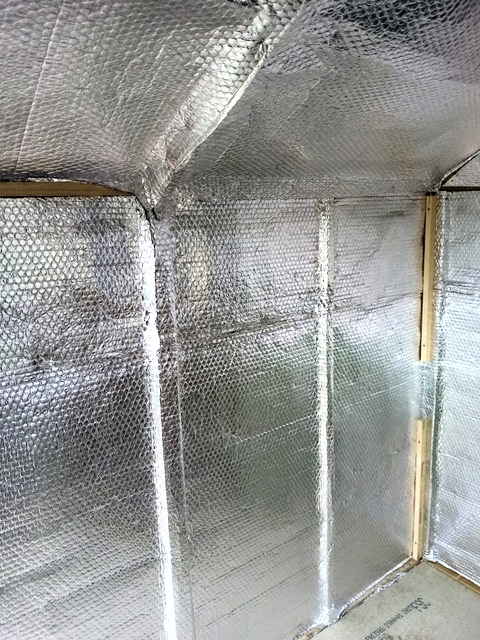 
|
|
|
| |
From Summer/Autumn 2020
Toasty 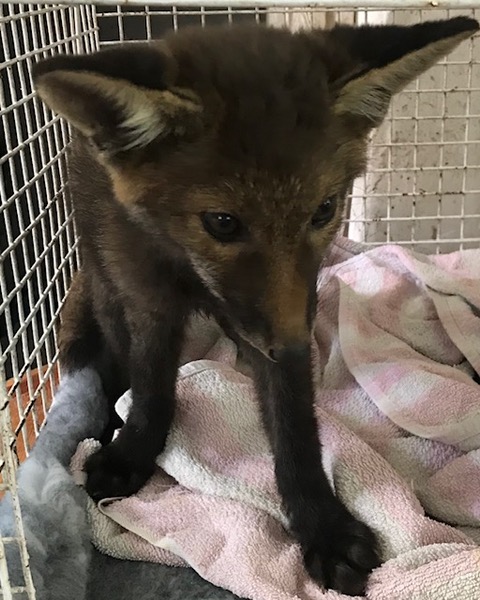
A special fox cub this year is Toasty.
We took in this beautiful little fox cub
in late May, the victim of a road traffic accident. He had been hit on the head and was very concussed, and was also extremely
thin and malnourished. Very happily he survived, against all the odds, and is an absolutely lovely boy. Once he recovered
sufficiently he spent periods of time each day with other cubs, coming back inside when he was tired. This very gentle boy
is being monitored all along to see how far his recovery will take him to full normality, as it is too early to say as yet.
Toasty was unusually dark in colour when he came in, with coal black silky fur on his tummy and chocolate brown
fur elsewhere. His fur has gradually changed and become more reddish but it is still unusual. He has such a sweet face and
is a really lovely little soul.
He has not made the grade for release this year as he has some residual brain
damage which means he would not be able to cope in the wild. It is possible he may improve enough for release next year, but
he is safe and sheltered here and he will have our care for as long as he needs it. He now interacts each day with disabled
resident fox Piper.
|
| |
| |
|
|
From Spring 2020
Goose 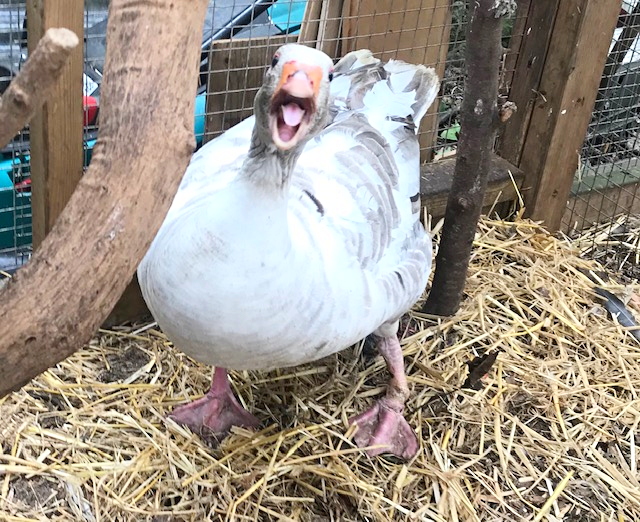
We recently took in a Greylag/crossbreed goose which had a nasty broken leg. He lived on the river
near Reading, and a kind lady had noticed his plight, and was feeding him. She managed to catch hold of him, and in
the struggle he whacked her temple with his wing, causing quite a bruise! But she held on and she then brought him to
Little Foxes. This was before the lockdown came into force and she proudly brought him in in a large fabric bag zipped
up at the top! My word, was he strong! He really did take some handling, but he did calm down after a couple
of minutes, and after a short rest to recover from his agitation, his leg was splinted and he was given pain relief and antibiotics
as his foot was also swollen and infected. The following day his foot was looking much better, and so he was penned
outside, and he then remained calm and co-operative, eating well and resting.
When the splint was removed after
three and a half weeks, the leg had healed nicely. It was quite a tricky break, low on the leg, near to the foot, and
it must have been very difficult for him to manage before he was rescued. As his leg healed, his foot also recovered.
He was then kept long enough to strengthen his leg a bit and make sure the mend was stable, and before long he was ready for
release back to where he came from. He immediately had a lovely swim which he must have enjoyed after his enforced rest!
He then settled down to a good preen, and I trust he is now happily living his life as he was before his unfortunate accident.
We don’t know what broke the leg, but I have speculated that it could have been caused by a collision with a boat on
the river. We will never know!
|
| |
| |
|
|
From Autumn 2019
Barn Owls
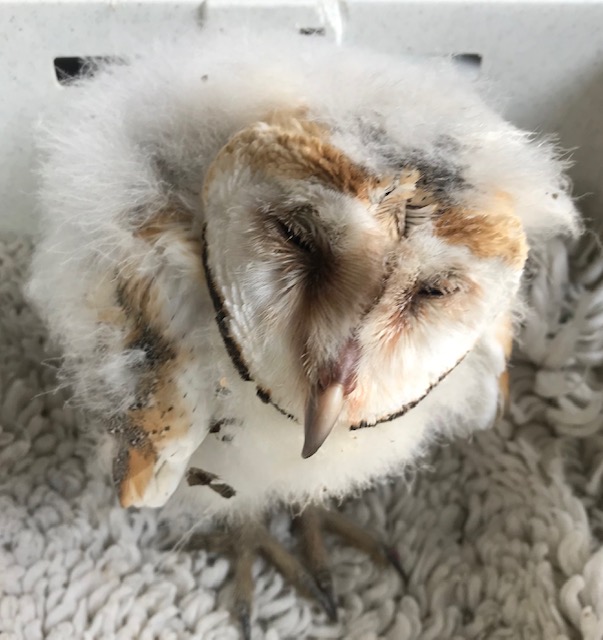
This year we have taken in four lovely barn owls. The first was an adult female that had been hit by
a car. Although she had no broken bones she did sustain nerve damage which, although very slow, is healing well.
She was joined after a few weeks by a young barn owl, probably male, who was just somewhat undernourished and weak. He responded
well to normal care and as soon as they were put together, our two lovely owls bonded strongly. Although the second of the
two owls is fit to go, we are holding him back while the female reaches full recovery so that they can go together. These
two birds are currently in a stable which has been converted into a large aviary at one of our really lovely release sites,
and they are very lucky as they will be released into a perfect area, with food of course provided for them for as long as
they come for it.
The third barn owl was found by a nearby road, unable to fly. I had a call from a gentleman who
had seen him and asked if we could help. I was given exact directions as to where to find him beside this road, but when I
got there the gentleman who had reported him had cycled back to the spot to help me, which was very considerate! There was
a thick hedge by the road through which the owl had been seen disappearing. With me on one side of the hedge and the chap
the other side we managed to locate this owl and luckily he was caught, not by me but by the cyclist, as the owl had emerged
on his side of the hedge!
This owl proved to be a juvenile which was clearly not managing very well, and was underweight.
Again there were no injuries, and so my initial fear that he had been hit by a car was unfounded, he was just malnourished
and consequently weak. A few weeks of rest and good food built up this owl very well, and after another few weeks to be sure
he has reached a good weight, he will be released from his aviary here so that food can be left for him on top of the aviary
after release.
|
| |
| |
|
|
From Spring 2019
Copper

He is now in with a group of cubs and his adoration is now focused on them. He still flattens his ears
and gives me a big foxy smile but he is already dodging my hand when I go to pick him up, and running about to make it difficult
for me, and his instincts of wariness are developing normally. He has developed his red coat earlier than most and he has
the most amazing blue eyes. All cubs have blue eyes when they first open, but these do change into anything from pale green
(stunning), tawny yellow through to dark brown. Copper’s are still blue, and I am watching with great interest to see
if they actually stay blue permanently. He will be a very unusual fox if they do. I just cannot look at him without smiling.
He is wonderful!
|
| |
| |
|
|
From Autumn 2018
Billy the Crow 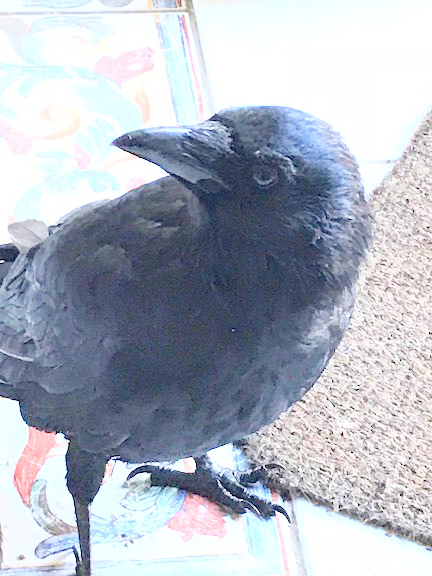 During the summer a young man brought in to us a juvenile crow which he had rescued as an orphan, and hand reared. On
his maiden flight, this crow had collided with a garden table and broken his leg. During the summer a young man brought in to us a juvenile crow which he had rescued as an orphan, and hand reared. On
his maiden flight, this crow had collided with a garden table and broken his leg.
The leg had a straightforward
fracture which was easily splinted, and mended nicely. He was housed here in an aviary with another young crow, and
soon showed himself to be a character and a half. He had imprinted somewhat on his kind rescuer, which is not unusual
with corvids which are reared alone, without the company of their own kind. However, I hoped this would soon wear off,
as it often does.
Every time I went anywhere near him he behaved like a very young bird, spreading and shaking
his wings and croaking pathetically. Even if disturbed when already tucking into food from a bowl, he would hastily
hop away from the food and do his “I’m starving, please feed me” act. However, he would not let me
touch him and began to react more normally to human approaches. He also interacted with his fellow young crow, and with
his mended leg and shiny plumage, he looked ready for release. This was a simple matter of opening up the aviary door
and letting the birds go when they were ready. Within a few minutes, both birds were out and exploring. Well,
that was many weeks ago, and Billy is still living in the garden and pretty much doing as he pleases in his domain.
He still shakes his wings at me whenever I approach, begging for food. One of his favourite spots is a wood pile, on
which he sits and comments on the events of the day.
The chickens are surprisingly tolerant of him, especially
considering he pinches their food from under their beaks – a cardinal sin – and easily evades any irritated pecks
they aim at him. His companion crow, which is not at all tame, also lives largely in the garden, but flies out during
parts of the day and occasionally does not return at night. One of the funny, if inconvenient things is that BOTH crows return
to their aviary to roost for the night. Not only that, but a hen which I took as a chick (which was one of a batch born
at a nursing home) also goes into the same aviary to roost, and a strange trio they are! Billy has roosted out of the
aviary on a few occasions, as has the other crow, and I expect they will eventually vacate – and the hen can be physically
put in to sleep with the other chickens when this happens!
Billy has been known on many occasions to pop into the
house, and I have seen him approach one of my resting dogs and tug his fur, sensibly keeping to the dog’s rear end and
well away from the sharp end! My four dogs are largely tolerant of this impertinent bird, although Dolly, one of my
Old English sheepdogs, chases him out of the house in a relatively non-aggressive way. She doesn’t hurt him but
clearly thinks houses are for dogs, not blooming crows. My two cockapoos, Candy and Coral, merrily chase all jackdaws,
crows, pigeons etc. into flight when they are out walking, but exercise great restraint towards Billy, clearly as a special
favour to me as they can’t see the point of him at all.
I expect you have seen reports of crows using tools
such as twigs, a sign of great intelligence. Well, Billy gave me a first-hand example of crow intelligence – he
had picked up a piece of discarded dog food which was a bit big and a bit hard for him to manage. He stalked across
to the water bowl put out for passing hedgehogs, holding his piece of food in his beak, and dipped it into the water, holding
it in until it had softened enough for him to eat! I watched this spellbound, and only wish I had been able to film
it.
I live in hope that one day he’ll start talking, like the crow at a castle in Yorkshire that asks visitors
“You all right love?” in a Yorkshire accent. I’ll let you know if it happens!
|
|
|
| |
From Winter 2017/2018
Jeff
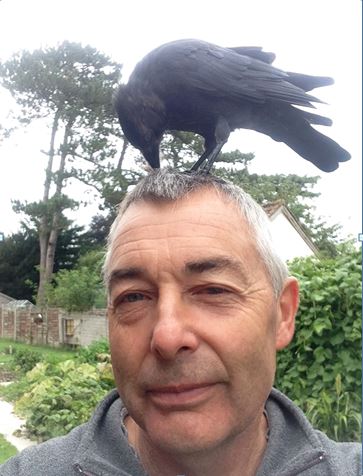 Jeff features on the front page of our Winter newlsetter with a jackdaw on his head, showing that this recent recruit
to our ranks is the right Jeff features on the front page of our Winter newlsetter with a jackdaw on his head, showing that this recent recruit
to our ranks is the right
type and fits in nicely!
As I mentioned before, Jeff is now taking permanent resident
corvids from us for lifetime care in his lovely aviary. He shows them real devotion and we are very lucky to have
him.
These birds are highly intelligent, and recent tests done by animal behaviourists have shown just how intelligent
they actually are; the use of tools being just one of their talents. For example, bending a piece of wire to make a tool
for extracting pieces of food put into deliberately awkward places. Science now says they are as intelligent as a four-
or five-year-old child. An odd comparison, but scientists like to relate everything to humans.
Jeff provides interest and mental stimulation to his birds to keep them happy and healthy.
|
| |
| |
|
|
From Summer 2017
Faith the fox cub
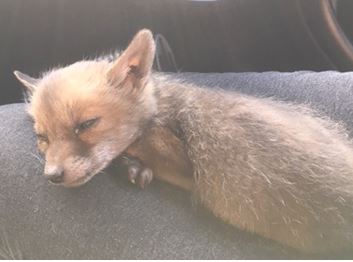
Little vixen Faith came to us from London. She was found on the road, sitting beside her mother who had
been killed by a car. She was a sad little cub, extremely depressed, very undersized, and she really had almost completely
lost interest in life. She did not want to eat and could only be coaxed to take a little bit of invalid food from a syringe.
I decided the only thing to do was to try and reignite her will to live, so I basically just tried to do this by showing her
kindness and love – simple as that.
Slowly she began, very quietly, to take a slight interest in life. One
day she very gently bit the ear of a soft toy rabbit, the very first sign of playing that she had shown. She began to eat,
which was a great relief. She grew a great deal and spent a lot of time outside playing with a group of cubs, which worked
its usual magic and gave her real happiness and enjoyment, something no human can ever do in the same way as contact with
others of their kind. faithfoxcub2.JPG
She is a really lovely little vixen and it is a delight to see her playing
merrily with other cubs, all of whom have, in usual fox cub style, welcomed her with huge enthusiasm and affection. I am now
completely confident that she can be released with her friends. Her pleasure in the company of the other cubs is a delight
to see. Interaction with one another is essential to the emotional health of foxes, and it is absolutely unfair to keep a
fox on its own, which is something I do not approve of. Humans believing they can provide everything a fox wants are deluding
themselves, as other fox company is so vital to the mental health and happiness of the fox.
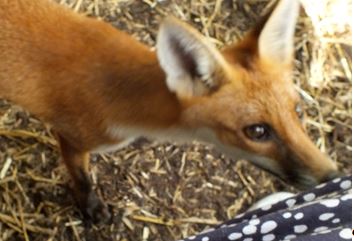
|
| |
| |
|
|
From Winter 2016/2017
Tawny owl rescue
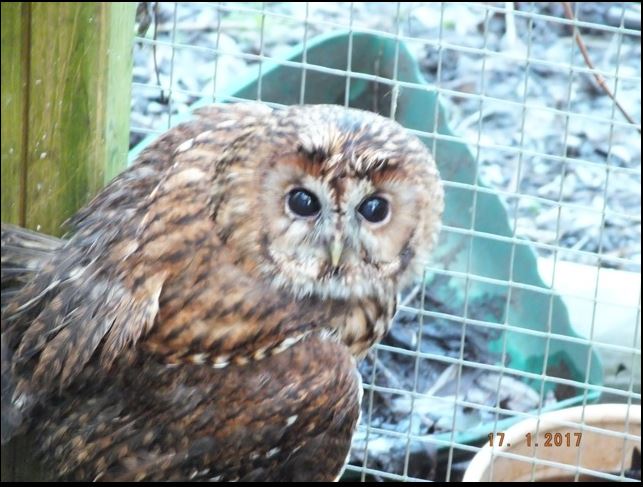 This owl came in at the end of December as a suspected road traffic victim. It was found in an
area of open land, semi-collapsed and unable to fly more than a few yards. Thankfully the couple who were
walking their dog and spotted this owl were kind enough to pick it up and bring it to Little Foxes. The
owl clearly had a damaged eye – very common in owls that have been hit by cars – and seemed to be very underweight. This owl came in at the end of December as a suspected road traffic victim. It was found in an
area of open land, semi-collapsed and unable to fly more than a few yards. Thankfully the couple who were
walking their dog and spotted this owl were kind enough to pick it up and bring it to Little Foxes. The
owl clearly had a damaged eye – very common in owls that have been hit by cars – and seemed to be very underweight. On close examination of the eye, I could see that the eyeball itself
did not look damaged, which is a very good thing, as they so often are. Tawnies’ eyes are large and
round, and vulnerable to injury. I cleared away the gunk from the eye, and had a really good look, noticing that the inner
corner of the eye had a small area of pink swollen flesh showing. Then I spotted, just on the corner of
the eyelid, what looked like a little spike of tiny feathers which were stiff with dried blood. I decided these had better
be pulled out carefully in case there was pus underneath. I tugged gently, and to my amazement, the feathers were not feathers
at all, because I found I was withdrawing a large thorn which came out smoothly! The poor owl had somehow
– goodness knows quite how – managed to get a thorn right through the corner of its eye. As
the thorn came out, the eye opened. I felt a bit like Daniel with the lion. Thankfully
the thorn had missed the eyeball, and within a few days the soreness it had caused had cleared up completely. This owl needed to be built up and so did not go back to the place it
was found, but fed up for three weeks and then released here. Food was provided at night on the top of
the aviary he had been in, but was not taken. He went out strong and fit and I am sure he is hunting successfully
for himself somewhere close by.
|
| |
| |
|
|
From Summer 2016
Gallery of some of the animals cared for this year.
|
| |
| |
|
|
From Winter 2015/2016
Update
Here we are once again with Spring around the corner, anticipating an influx of needy orphans.
We can never tell how many will come our way, but we can be sure there will be many – we will do our best for them,
and with the marvellous continuing support of our loyal members we will try and return as many as possible to the environment
in which they belong. A quick update on some of last year’s orphans – all the fox cubs were
released – all those that were in fosterer Helen’s care, and all those in mine. We are delighted with the
reports coming back from the release sites. The two little girls Lottie and River are doing extremely well, a great
relief after their very shaky start! (see pic below in the Summer article of these girls growing up). Both the
baby polecats that we looked after last summer were also successfully released, fit and well and very feisty! |
|
|
| |
From Summer 2015
Polecats
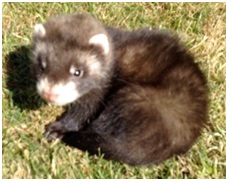 We have also had the pleasure of the company of a baby wild polecat this summer. A ferret rescue contacted us having taken
in what was originally thought to be a ferret, but Clare, the lady who runs the rescue, realised he was probably a polecat,
and sent me a picture. It was quite clear this was a proper little polecat. He was a delightful character,
as they all are, very playful and lively. He has now been fully released, after spending a few days in a release pen
to get used to his new surroundings. I am told he is taking the chicks left out for him and he also appears to be killing
rats. Natural predation – infinitely preferable to any of the vile so-called “control” methods devised
by man. |
|
|
| |
From Summer 2015
Fox cub update
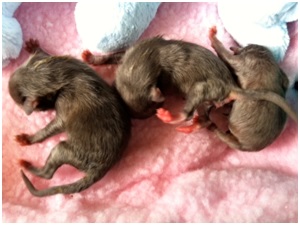 Last time I told you about the three tiny little female fox cubs that came in from Bermondsey. I am sorry to say that
one little cub died at about four weeks of age, very suddenly, apparently of an infection that did not respond to antibiotics. Last time I told you about the three tiny little female fox cubs that came in from Bermondsey. I am sorry to say that
one little cub died at about four weeks of age, very suddenly, apparently of an infection that did not respond to antibiotics.
The two remaining little vixens, River and Lottie, have, thankfully, survived, but it has not been plain sailing,
not by any means. Throughout their time here they have battled through numerous setbacks, so much so that, even though
they were inevitably compromised by how very little of their mother’s milk they had received, I do feel they may have
been born slightly prematurely. They were very tiny indeed when they came in, and I have had cubs of a very similar
age that have thrived a lot more consistently than these little ones. They both regularly frightened the living daylights
out of me by temporarily going off their feeds, although normally they were excellent little guzzlers. They remained
very small for their age. Most worrying of all, just when I thought I could relax a bit, at a stage when they were on
solid food and getting on very well, they simultaneously went weak on their back legs! Every supplement under the sun
(and they were already on supplementary vitamins and calcium!) was added to their diet and thankfully this also proved to
be a temporary setback.
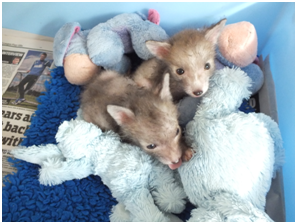 Lottie retained one problem – her anal sphincter was not quite closing completely, resulting in some leakage which caused
soreness. By now I was of the view that these brave little cubs would overcome whatever arose, so I kept her clean and
comfortable, didn’t panic, and sure enough everything came right in that department too in due course. Lottie retained one problem – her anal sphincter was not quite closing completely, resulting in some leakage which caused
soreness. By now I was of the view that these brave little cubs would overcome whatever arose, so I kept her clean and
comfortable, didn’t panic, and sure enough everything came right in that department too in due course.
I
gradually introduced Lottie and River to the other cubs, and as usual with cubs everyone concerned showed total delight at
the introduction. They quickly showed they were robust enough to play very happily with the others, and soon they were
spending all day with them, just coming back in at night for a proper rest. They have now been penned outside with the
others for several weeks, and they are absolutely brilliant. They are slightly smaller than the others, but they are
within a normal size range. I really feel now they can be released with the others. They have a rich mixture of
colours in their fur, and Lottie is unusual in that she has pure white socks on her back legs rather than black ones.
See the back page for photographs showing their gradual progress.
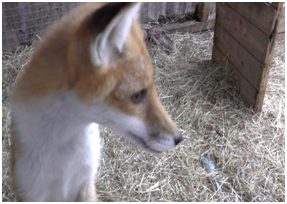 Lottie and River’s friends are Sophie, whom I told you about last time, and Reggie and Mr Softy. Reggie came from
Lambourne, and was found sitting outside a fox earth, next to his dead sibling. Two ladies walking their dogs found
him, and unsure what to do, tried walking away from him, whereupon he cried piteously. They picked him up and took him
home, and I believe they were quite right to do so. Something had obviously gone wrong as his sibling was above ground,
dead. Reggie is a fabulously handsome boy. Mr Softy came from Hampshire, having been found lost and all alone.
He is this year’s big soft lad. He is a rich dark red, a big boy, and soppy as they come. All five cubs
show great fear towards strangers, as they should, but at present still regard me as a Nice Person and a Good Thing, although
their interest in me is waning, exactly as is normal. It won’t be long now until release time. Lottie and River’s friends are Sophie, whom I told you about last time, and Reggie and Mr Softy. Reggie came from
Lambourne, and was found sitting outside a fox earth, next to his dead sibling. Two ladies walking their dogs found
him, and unsure what to do, tried walking away from him, whereupon he cried piteously. They picked him up and took him
home, and I believe they were quite right to do so. Something had obviously gone wrong as his sibling was above ground,
dead. Reggie is a fabulously handsome boy. Mr Softy came from Hampshire, having been found lost and all alone.
He is this year’s big soft lad. He is a rich dark red, a big boy, and soppy as they come. All five cubs
show great fear towards strangers, as they should, but at present still regard me as a Nice Person and a Good Thing, although
their interest in me is waning, exactly as is normal. It won’t be long now until release time.
Helen’s
four cubs (mentioned last time) have taken the award for being the most determinedly stroppy little rascals this year.
They consistently hide so effectively in their run that Helen says you wouldn’t know there were any cubs in there at
all. These wild characters will soon be released.
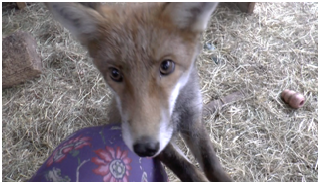 We would have had more more cubs here this year, but we have been lucky enough to establish a new relationship with a fox
cub carer who has now joined forces with Little Foxes. We welcome Jackie on board, who is looking after six little cubs
in Hampshire which would otherwise have come to us in Oxfordshire. Jackie has lovely accommodation for her cubs, and
we are delighted to have this new extension to our fox cub facilities. More pictures and further updates of the cubs next
time. We would have had more more cubs here this year, but we have been lucky enough to establish a new relationship with a fox
cub carer who has now joined forces with Little Foxes. We welcome Jackie on board, who is looking after six little cubs
in Hampshire which would otherwise have come to us in Oxfordshire. Jackie has lovely accommodation for her cubs, and
we are delighted to have this new extension to our fox cub facilities. More pictures and further updates of the cubs next
time.
|
| |
| |
|
|
From Spring 2015
First casualty of the year
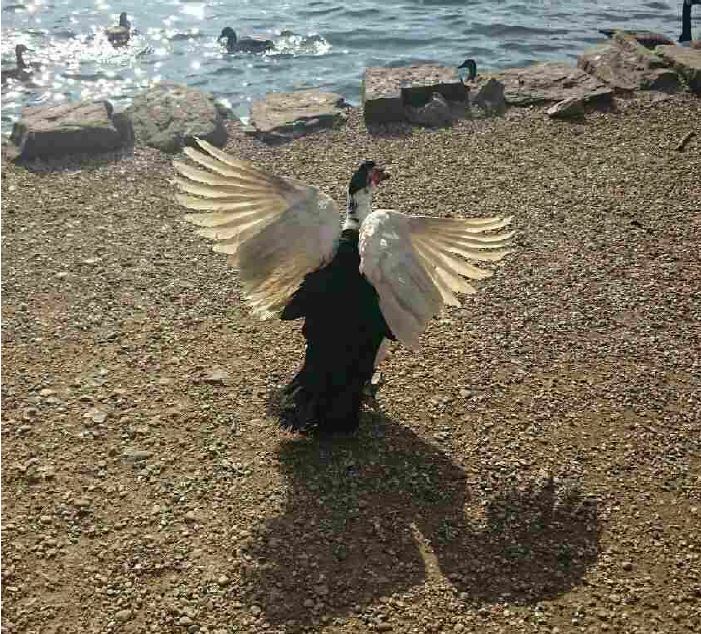 The first casualty we took in this year wasn’t strictly speaking a wildlife casualty. A very large Muscovy drake was
brought here which had come from a wildlife reserve. A visitor had noticed that this bird was so lame that it could hardly
move. She enquired about getting help for it, and a member of staff said it was their policy to let nature take its course,
and that they expected a fox to catch this bird, but added that, if someone was willing to assist, they were happy for the
bird to be taken away to be helped. The first casualty we took in this year wasn’t strictly speaking a wildlife casualty. A very large Muscovy drake was
brought here which had come from a wildlife reserve. A visitor had noticed that this bird was so lame that it could hardly
move. She enquired about getting help for it, and a member of staff said it was their policy to let nature take its course,
and that they expected a fox to catch this bird, but added that, if someone was willing to assist, they were happy for the
bird to be taken away to be helped.
Technically the bird was not a pet, or owned by anyone, so it sort of qualified as
wildlife although Muscovies are really a domesticated breed.
When I opened the box in which the drake had been transported
I was taken aback by its size. It was huge! It was quite a struggle to lift him out of the box, and his wings were tremendously
strong. I examined the leg and was relieved to find no broken bones. Ducks frequently do go lame – perhaps that’s
why the expression “lame duck” is used – and commonly it is just a sprain, or sometimes the webbing between
the toes gets damaged.
A bird as large as this fellow would be in real trouble with a damaged leg, and unable to carry
his own weight.
Although on admittance he was quite a handful, flapping his powerful wings so strongly that I could barely
hold him, he soon settled down and became a model patient. He was very sweet natured, calm and, crucially, responsive to treatment,
which consisted mainly of rest, and also homeopathic remedies added to his food.
The reserve he came from was really
lovely, with huge lakes teeming with all sorts of wildfowl, and so after about six weeks, when he was fully better, it was
best for him to go back home. His rescuer had wanted to do the release, but unfortunately in the end was not able to do so,
and the days were passing. It was a shame for him to be away from his home and his friends any longer, and so our fosterer
Claire very kindly took him back home. She thoroughly enjoyed the release, as he was clearly welcomed back by the other Muscovy
drakes, and was soon back in the bosom of his family!
The photograph shows him on release, clearly happily standing on
both legs, and flapping those mighty wings!
|
| |
| |
|
|
From Spring 2014
Lexie
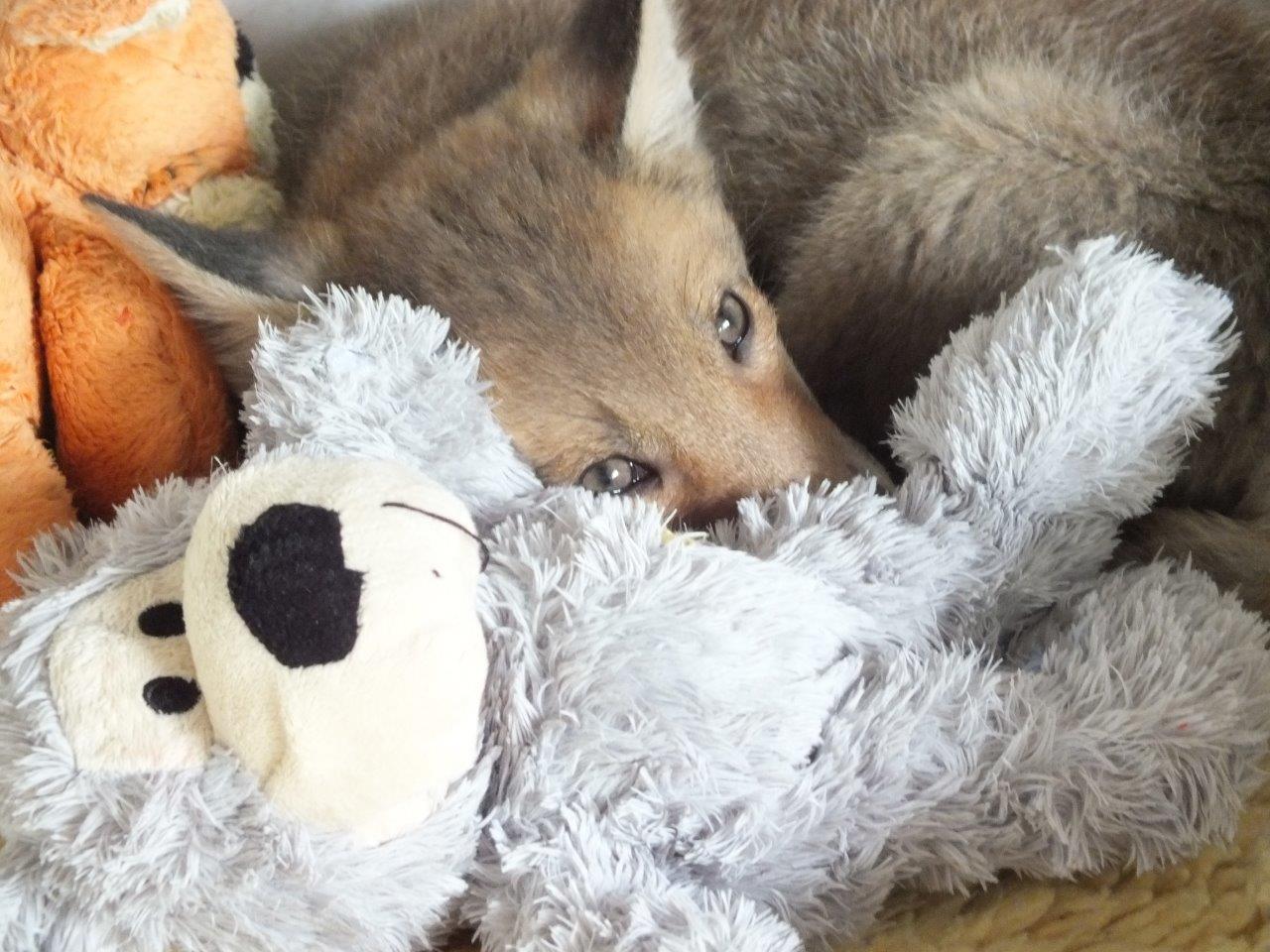 This little cub is another fine example of the potential for recovery of wild animals, if the animal falls into hands that
do not automatically reach for the lethal injection. This little cub is another fine example of the potential for recovery of wild animals, if the animal falls into hands that
do not automatically reach for the lethal injection.
Lexie was found on the pavement by a postal worker, early
in the morning. He went over to her and picked her up, and he was very shocked by what he saw. Where one of her
front legs should have been Lexie had, dangling from her shoulder, what looked like a couple of inches of filthy rag,
with a broken bone amongst the mess. Something had bitten her leg off, and the assumption is it must have been a powerful
dog.
I must thank Andrew Bartholomew, our vet, for his very kind and very considerate care of this
little cub. She was fitted in at the vets that day for an operation to remove what was left of her leg. Andrew did not
cut as far back as he could as he suspected the amputation wound could become infected, and he needed to have something left
to cut back if this happened. Although at first the wound stayed clean, unfortunately after a few days it began to open
up. An intensive antibiotic and cleaning regime followed here at the sanctuary, and then she went back to the vet for
a second operation. I think everyone at the vets fell in love with this absolutely lovely little fox. She was
so tolerant, brave and calm throughout her ordeal.
Her second operation scar remained clean and healthy, and she
is now fully recovered, and bouncing around on three legs brilliantly well. She plays every day with other cubs, but
she is not releasable now of course, so will stay here. I am sure Velvet, Rosie and Ladybird will welcome her into their
group with great enthusiasm.
|
| |
| |
|
|
From Winter 2013/2014
My Experience Of Being A Wildlife Foster Carer - by
Claire Beard
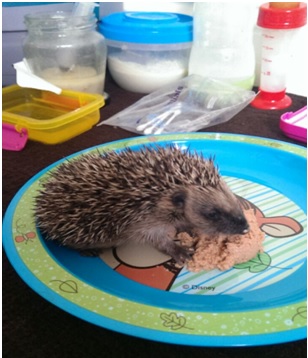 I came across Little Foxes wildlife rescue by pure luck last year after I stumbled upon two tiny hedgehogs. Their eyes
were still closed and they hadn’t developed their teeth yet, so had to be bottle fed. I spoke to Penny and asked for
advice about caring for them. She asked if I felt I could try and raise them as I was showing such an interest in them.
Because of her amazing advice [and mainly because of Claire’s own excellent care! – Editor] the little
ones were released as big ones this spring. I came across Little Foxes wildlife rescue by pure luck last year after I stumbled upon two tiny hedgehogs. Their eyes
were still closed and they hadn’t developed their teeth yet, so had to be bottle fed. I spoke to Penny and asked for
advice about caring for them. She asked if I felt I could try and raise them as I was showing such an interest in them.
Because of her amazing advice [and mainly because of Claire’s own excellent care! – Editor] the little
ones were released as big ones this spring.
I have always loved wildlife, so
I was honoured and overjoyed when Penny asked if I would like to become a foster carer for Little Foxes. Naturally I jumped
at the chance.
This year has been my first year,
and I have loved every busy day of it. Thanks to Little Foxes I have been given the unique opportunity to care and nurture
some incredible wildlife.
Even though it is to be expected, I am still devastated when
one of my animals passes. Penny is always supportive and reassuring, even when I seemed to have a month of incredibly bad
luck. She assures me this just happens sometimes, and a run of bad luck is just one of those things.
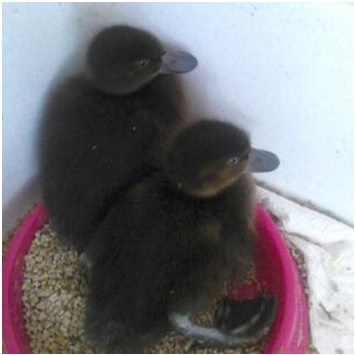 This year I have been very busy with baby birds. I have had lots of blackbirds, pigeons, some baby finches, a sparrow, a swallow
(amazing, such a beautiful bird), baby tree creepers, baby robins, three baby moorhens (adorable), collared doves, two baby
ducklings, and as the autumn approached, my absolute favourite, lots of hedgehogs! This year I have been very busy with baby birds. I have had lots of blackbirds, pigeons, some baby finches, a sparrow, a swallow
(amazing, such a beautiful bird), baby tree creepers, baby robins, three baby moorhens (adorable), collared doves, two baby
ducklings, and as the autumn approached, my absolute favourite, lots of hedgehogs!
I
was asked to give a talk at my local children’s’ centre about hedgehogs, which I gladly accepted because the more
people that learn about them the better. I also gave a talk at my son’s school.
I will take in absolutely any animal or bird that I am asked to, but I am well aware of when I am out of my depth. When
this happens I will contact Penny and arrange for the animal or bird to go to her.
I
had to do this with the swallow as they are very fragile birds and Penny has an enormous amount of knowledge and experience.
I must add because it was drilled into me, I have to release all animals and birds back into the wild, unless there is no
chance they will survive. Sometimes this is incredibly hard because it is impossible not to fall in love with their little
characters.
I have had a fantastic although sometimes upsetting year and I can’t
wait to see what incredible animals and birds I am lucky enough to care for in 2014.
|
| |
| |
|
|
From Summer/Autumn 2013
Baby Hedgehogs 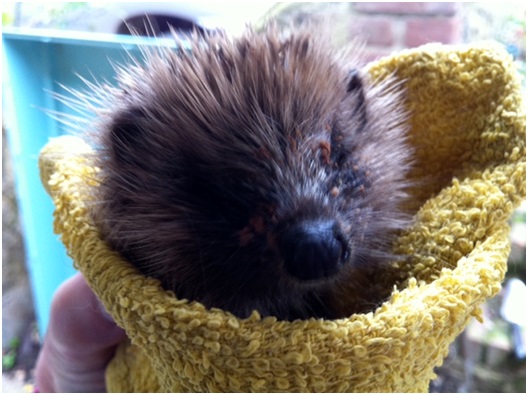 Hedgehog numbers are also in alarming decline, and so we are even more pleased these days when we can save the lives of these
animals. Hedgehog numbers are also in alarming decline, and so we are even more pleased these days when we can save the lives of these
animals.
Any wildlife rescuer will tell you that one of the most unpleasant jobs that comes their way is the de-fly-egging
of a hedgehog. Flies will always home in on any sick or declining animal, and hedgehogs are particularly prone to the
horrible depredations of the flies. Even worse than being faced with a hedgehog covered in fly eggs is being faced
with a hedgehog covered in tiny maggots that have only just hatched. They get in amongst the prickles and the fur in
the most adhesive and frustrating way. Anyway, in case you’re reading this eating your tea, I won’t go on,
but take it from me it’s a really nasty job especially as hedgehogs, of course, roll up in a ball, making the whole
procedure 1000 times more difficult!
The baby hedgehog on the front of the Newsletter came in very cold, wet through
and absolutely covered with fly eggs. I spent ages removing all these horrors, getting the animal warm, and administering
fluids, then I finally put him in a warm cage and hoped against hope that he would survive. He was actually in a “death
position”, very weak and looking a dead cert no-hoper.
I looked at him last thing, checked yet again
that there really were no eggs or maggots I had missed, and said to myself “he’ll never survive the night”.
On checking the next morning, he was in the same position, but still breathing. A couple of hours later he was
moving, very shakily, around the cage. I was amazed. I continued to give him warm fluids subcutaneously.
As the day progressed, he continued to improve, and finally, the following day, he started to eat.
As I
write this he is still doing well, some two weeks later, and he is eating normally and putting on weight.
This case is very encouraging, as so often you do your utmost to save a little hedgehog dying because he is weak
and hungry, and when fly strike is evident, there is a strong chance you may fail. Even though this little hog weighed
less than 100 grams when he came in, he fought back and managed to hang on. So all being well he will continue to eat
us out of house and home all winter and be a fine, strong hog to go out on release in the spring.
|
| |
| |
|
|
From Spring 2013
Thank you so much!
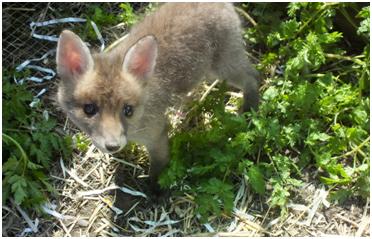
In the last Newsletter I appealed to you for donations to reimburse our funds after further expensive repairs
had to be done to our large fox pens. Well, you are magnificent, and I am thrilled to report that the outlay has now
been replaced, with a bit over, thanks to your kindness and generosity. I cannot tell you how grateful we are for your
help, which has eased our worries greatly.
With the continuing recession our income continues to be badly affected,
but with support like yours I am sure we can keep taking the little ones that need us. We could not do it without you!
|
| |
| |
|
|
From Winter 2012/2013
A Red Kite Visitor 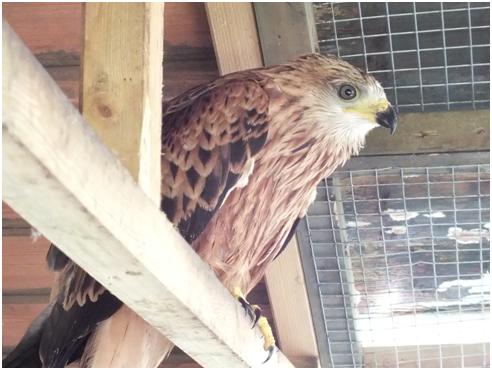
As you can see from the image, we had a magnificent patient last year, a glorious red kite.
The
bird was found in a collapsed state in a field, and was brought over to us the same day. Bodily there did not
seem to be any problem, but the bird was incapable of standing up at all. I know that red kites have a defence technique that
involves them feigning death by lying prone, but even when the rescuer reached out and picked up the kite, it did not react.
My conclusion was that the bird seemed to be concussed. I hoped and prayed that there would be no further complications,
indicative of poisoning, as some birds of prey are so detested by ignorant bloodsporters and a few others, that they are killed
illegally sometimes. Poisoning is not uncommon.
To my relief, the kite seemed a little better the following
day, and with warmth and care, continued to improve. I administered fluids for a couple of days, then gently force fed
the bird with a little food, and after that the bird started to feed quite eagerly, taking the food by himself with no trouble.
He graduated into an aviary, and after a couple of weeks more for him to strengthen, during which time the sight of
him took my breath away again and again, so beautiful a sight was he, I released him to join the other kites that are numerous
in my village. I provided food on the top of the aviary for a while, but he left us a strong and magnificent bird, and
I have no doubt he picked up the threads of his life with no difficulty.
|
| |
| |
|
|
Kit Kat and Crunchie:
Two of our 2012 fox cub casualties...see last picture below for update!
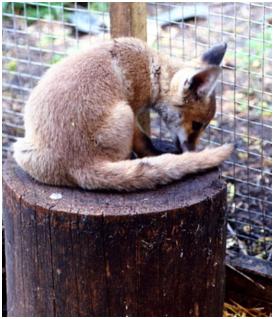
Kit Kat
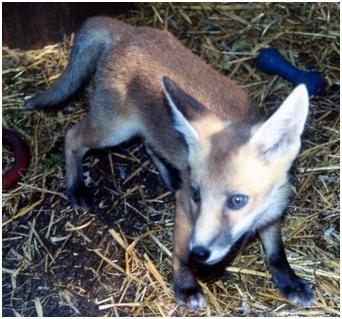
Crunchie
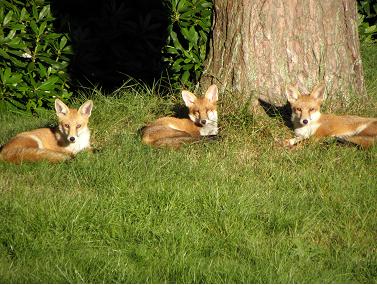
l-r: Kit Kat, Kitty and Twix. They are three of seven cubs we have recently released. All are in excellent
health, and we have had marvellous reports of them from the release site, including four or five of the cubs having been seen
playing together many evenings.
|
|
|
| |
|
From
Spring 2012
Crows are cool!
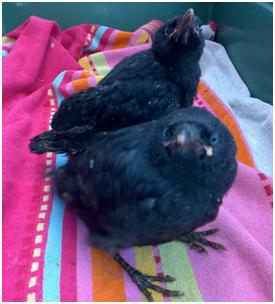 The crows are another of those species that some people choose
to dislike, but the crow family is actually one of the most fascinating of all. They are extremely intelligent,
and the young of such species as jackdaws, magpies and crows are very interesting to watch at the close quarters involved
when you are hand rearing them.
They are noisy, demanding, and have plenty of attitude. Their intelligence
comes through from the earliest days, and their development is very interesting to observe. They also have a range of
crooning noises in addition to the well know squawks, and although these are very difficult to describe, they make you laugh
out loud when you hear them. They seem to be talking to one another. They also make a very comical noise when
fed, a sort of indignant, gulping chatter as the food goes down, which is one of the annual joys for those of us who hand
feed young corvids. It is really comical, unique to the corvids, and can win over anyone who is not already a fan!
One of my fondest memories is of a young jay I hand reared who automatically starting mimicking sounds – before
he went on release he could do a perfect imitation of my neighbour calling her cat, and also could mimic my sneeze to perfection.
Brilliant!
|
| |
|
From Spring 2011
Fox Cubs
At the time of
writing, we have the first two cubs in, no doubt to be followed by many more.
Sponge Bob was the first to arrive,
a very young orphan, still with eyes closed. He settled well, and very quickly developed a fixation with the feeding bottle
which he still has. The suction power of a determined fox cub should not be underestimated, and Bob is a master of his craft.
Now he is a bit older, with eyes open and managing at least four steps at a time before falling over, and with his teeth through,
he is being weaned onto soft solid food, and his first attempts consisted of him trying the tried and trusted power suction
approach, possibly trying to suck the bowl down along with the food inside it. It worked, and squidgy food ended up inside
Bob (well at least some of it did, the rest being liberally smeared all over Bob and everything around him). He is a smashing
little chap, and judging by his large paws, going to put all that food to good use by growing up to be a chunky lad.
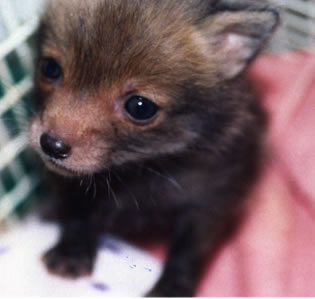
Second
arrival was a thin little waif brought to us by the receptionist of a vets some distance away. I have named this cub Pixie
(left) because of his tiny wistful little face. He was ribby and very sad, but he has now blossomed into a very happy and
settled little animal, very playful and particularly fond of very small soft toys that he can clamp between his teeth and
parade around with great satisfaction. The effect is only spoiled when he trips over his own feet, and the small toys usually
end up resting in the middle of his bowl of food, but he’s happy.
The two boys are now able to play together,
and this is always a great thing for cubs, as they absolutely love one another and thrive better with company!
|
|
From Autumn 2007 Hedgehog Heroes
The humble hedgehog does not always get the appreciation
it deserves. Here are a few stories of recent hedgehog visitors that show how heroic and stoic they really are.
1. A Devoted Mother
It’s a bit much when you have laboured diligently to prepare a nice snug nest for your forthcoming youngsters,
gone through the business of giving birth to them, and just a couple of days later, find your whole world turned literally
upside-down by some busybody humans.
Meg, a hedgehog currently resident at Little Foxes, found herself in just
this frightening situation a few weeks ago. She had spent ages collecting grass and scraps of plastic and material
together into a nest, and then some people decided to tidy up their garden and pulled the whole thing out of its snug
position amongst some tree roots. They certainly didn’t mean to, of course, but the result was one
adult and three very tiny hedgehogs in a cardboard box arriving at Little Foxes. The little family was
put into a roomy cage and a very watchful eye was kept on them to see if the mother rejected or attacked her youngsters
due to the disturbance she had suffered. A mere hour after arrival, distinct sounds of suckling could be heard.
Two days later they were moved into an outside pen, with a new nest (much inferior to the old one as it had been made
by a mere human) and left to their own devices, apart from hearty meals provided for this devoted mother hedgehog.
Only a couple of checks have been made on the babies, as the least possible disturbance is caused in such situations,
but a week ago they were checked again, and the babies are now fat and toothy and looking very good indeed. Soon
they will no longer need their mother, and she will want to go off on her own again, so she will be released and
the babies will be kept here until at a releasable weight. The stoicism and maternal devotion of this mother has
been heart warming to witness. She has coped with adversity and fear, and just got on with the job of looking after
her brood. (STOP PRESS: ALL FOUR HEDGEHOGS NOW RELEASED.)
2. I am not a rat - I am a hedgehog
Also currently resident at Little Foxes is Rat-trap, so called (perhaps not very tactfully) because she got caught
in a lethal rat trap. I hate these contraptions, and I think they (and snares) should be outlawed along with
gin traps as horrible examples of human brutality.
Poor old Rat-trap was minding her own business foraging about at night and no doubt decided to investigate whatever
bait had been put in the trap. When she arrived here after Richard, our helper, collected her, I was disappointed
to find that the householder had not done as I asked and brought her indoors away from the flies, and consequently she
was not only injured, but also covered in fly eggs. I removed all of these before they turned into maggots and
started eating her alive. She was given fluids and an antibiotic injection, and placed in a warm cage to recover.
That little hedgehog has doggedly got on with life, although at first unable to stand up properly withough keeling
over onto her side. She attacked her food bowl with a sideways motion that worked very well, and likewise a drink
of water went in sideways. She progressed within two weeks to being able to walk around her cage with only,
now, the occasional fall onto her side, quickly corrected. Whether she will fully recover remains to be seen -
I doubt it myself, and I expect her to retain a degree of nerve damage. If so, she will stay as a permanent
resident at Little Foxes, very probably under the protective wing of Sue, one of our fosterers, who has other permanent hogs
in her care.
3. Plastic hurts
The final one of our three heroes, who are just examples of many of their kind, is a little chap
who had not even reached maturity before he fell foul of human filth and lack of concern. He is just one of the
thousands of animals that get caught in plastic waste - in his case it was a ring of plastic from the top of a drinks
can. (These should always be snipped into pieces before disposal so that they cause no harm).
This hog was taken by his rescuer into a vets, where the ring was removed, and he was then passed on to us.
He had a deep welt across his stomach where the plastic had cut into him. His spines had protected his back from
similar damage.
Despite having an infected wound stretching
from side to side of his tum, he carried on regardless, eating and growing well while time and antibiotics healed the wound.
He is now very close to release, restored and repaired.
|
 |
 |
 |
|
From Winter 2022/2023 Barn
owl
The New Year brought us a very sad case. A barn owl was
brought in which had been found in a rat trap. The owl’s leg is very badly damaged, broken and torn by this horrible
contraption. He has been given pain killers and his leg has been splinted, but the outcome is far from certain. These traps
are horrible. If they are left in the open they can catch hedgehogs, trap the leg of a fox or a cat, or kill birds. If they
are baited with food - such as a dead day-old chick - they can attract a bird of prey. Yet another example of the horrible
damage we inflict upon wildlife. We are currently trying to save the barn owl’s leg.
 
|
|
|
| |
From Winter 2021/2022
Little vixen
These pictures are of a little
vixen who came to us at the end of October, suffering horribly from mange.
She was lying in a garden, having just about
given up. Our lovely helper Phil collected her and she was soon safe at Little Foxes. Her skin was crusted and thickened,
she had lost much of her fur, she was covered in flaked skin and she had two horrible sores either side of her tail, each
about the size of a 50p piece.
She was treated here with antibiotics and the treatment for mange, and given the care
and loving attention she so desperately needed.
The second of the two photos shows her well on the way to complete recovery.
Nothing is more pleasing than seeing an animal in such dire trouble return to health in this way. She regained her spirit
and lust for life, and on her return home to the garden in which she was found, she shot out of the carry box at speed and
ran rapidly to an obviously well known route through to the back of the garden, healthy and whole again. Wonderful!
|
| |
| |
|
|
From Spring/Summer 2021
Albino bird
Nature
occasionally throws up an anomaly that is an albino, an animal that has no pigment in fur or feathers, skin or eyes.
We
have recently taken in an albino baby bird which is either a robin or a dunnock – the jury is still out!
The bird
is absolutely delightful – very bright and perky and full of beans. Our fosterer Carol is looking after this bird and
is clearly captivated by it!
We have previously taken in an albino hedgehog, and there is something special about these
little quirks of nature. They are vulnerable in the wild as they are so noticeable, and both predators and taxidermists (yes,
really) might be after them, so it is usually safer to keep them in sanctuary conditions.
From Winter 2020/2021
Remembering Mungo - and introducing his great grandson Ludo
Little Foxes does take in stray hens from time to time, and the very first one
we took in was in fact a bantam cockerel, found wandering in Oxford, whom I named Mungo. He was a bit of a tyrant but was
very much loved. He sired a few offspring, having two fine sons, and then two grandsons. He and his sons are no longer with
us, but his two grandsons are, and his great grandson arrived a few months ago, along with two great granddaughters. The eggs
are usually removed from our hens but every now and then some are hatched!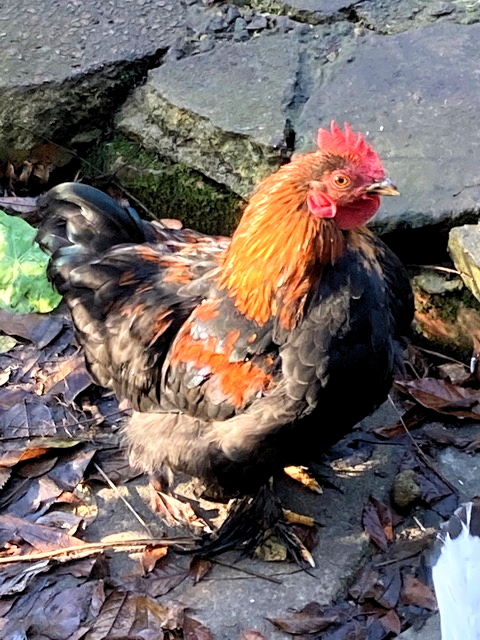
|
| |
| |
|
|
From Summer/Autumn 2020
Great Crested Grebe
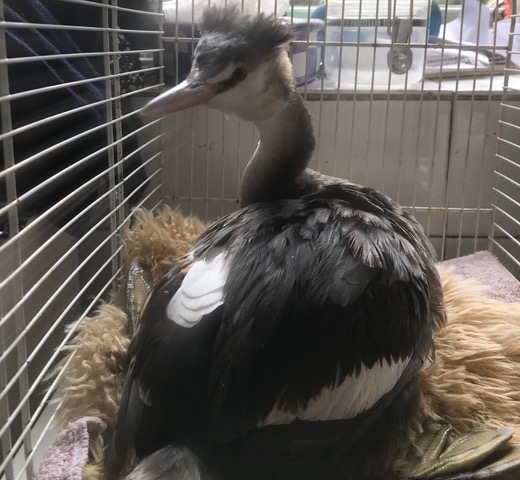
A short while ago we took in a juvenile great crested grebe, a really lovely bird who had become stranded on the ground.
This species of bird is one that is designed specifically for life on water, and if they land on the ground they cannot take
off again, only being able to take off successfully from the water. They can also barely walk on the ground, their legs being
positioned far back for maximum benefit when swimming.
On examination, the bird was found to be unharmed and uninjured.
A check with our friend Ian from the British Trust for Ornithology confirmed that although a juvenile, he was old enough to
fly and be independent. All his baby stripes had gone from his plumage, indicating his stage of maturity.
The day
after he came in he was released back onto a large body of water to carry on with his life as he should. He was very feisty
and strong and showed every sign of being able to resume life in the proper environment. It was a pleasure to have this lovely
bird, even for such a short visit.
|
| |
| |
|
|
An Appeal in 2020
We don’t like to ask at this difficult time, but as you may know, charities are suffering at the moment.
Understandably, most donations are going to human charities, such as those for the homeless, and nobody would begrudge that.
But we still have to feed our casualties and provide for their needs. We overwintered nearly one hundred hedgehogs in
2019/20 and believe me, they eat their heads off! At present, and for some time, our outgoings are exceeding our income
by quite a worrying margin. So could you please consider sending us a donation to help recoup the costs of all those
hungry hedgehogs? Please click on this PayPal Giving Fund link if you can help us. Thank you very much, and please all take great care of yourselves! |
| |
| |
|
|
From Autumn 2019
Fox Cubs As I write
this two of our three groups of cubs have been released. The third group will also be on their way soon. As always I have
been fascinated and captivated by these cubs, marvelling at their unique appeal, their intelligence, beauty and complexity,
their mischievousness, their spirit, and above all, their heartbreaking innocence. They play so happily and so innocently,
and while I have the care and responsibility for these wonderful little animals I try not to think about the cruelty meted
out to foxes by sub-human monsters, whose wickedness I will never understand as long as I live.
We do, of course,
go to great lengths to only use release sites well away from the brutes of the hunting and shooting world. We do the very
best we can for them and it is wonderful to hear from the release sites of their sightings of our cubs playing merrily and
having a whale of a time as they enjoy being truly free. Wildlife cameras strategically placed capture some of these rumbustious
games, and are a joy to watch. Their shenanigans include much digging of holes, throwing around of anything that represents
a toy, and streaking around in hot pursuit of one another as they play without a care in the world. One group even dug up
some potatoes on their first night out – oh dear! So all the hard work and worry is fully and completely rewarded to
hear of these things, and to also see film of their happy and harmless hooliganism!
I had a special soft spot this
year for Copper, a glorious boy with beautiful eyes, and a happy go lucky and kind nature. He is an extrovert and ebullient
chap, instigating all sorts of goofy and exuberant play with his friends. He was on the front cover of the last Newsletter
and a more grown up Copper graces the back page of this one.
When we hear from our release sites that our young
foxes have gone on to stay in the vicinity and, as in the case of one site this year, hear that a young vixen we released
last year has produced cubs of her own, our reward is complete. I also remember hearing from a release site that one of our
released youngsters, a fox with only half a tail, has been seen, very close to the release site, over two years after release.
His tail made him easily identifiable.
|
| |
| |
|
|
From Spring 2019
Walled Garden Alert!
Have you got a secure walled garden? If you have, perhaps you would consider
taking on a hedgehog that has a disability which makes it unfit for release, but can live a good life in safe surroundings
with food provided.
The hedgehog may, for example, have only three legs, having had to have a leg amputated due
to a serious injury. It may be a little bit brain damaged, or generally weakened after having recovered from eating or drinking
a toxic substance such as ant poison.
The hedgehog will enjoy a life in a garden, and it is as close as safely
possible to a normal life in the wild that we can provide. It will repay your kindness by eating up some of the things you
would perhaps rather not have in your garden, such as slugs, and you should have the pleasure of seeing the hedgehog snuffling
around in the garden enjoying life.
If you think you could help in this way, please contact us either through our
website, our Facebook page or just by ringing on 01844 279469.
|
| |
| |
|
|
From Autumn 2018
Fox Cubs
Well, they’ve
all gone off now to their release sites and are reportedly having a merry time. As always they have left me with lovely
memories of their time here. For example, the two Hampshire boys, Lawrie and Eddie (see below) not brothers, but you
would honestly have thought they were, they were so similar. They both came in very young indeed, eyes and ears still
closed, but thankfully the hand rearing was something they took to enthusiastically, and they thrived. Of the two, Eddie
was just marginally the more extrovert, and he was truly a joy to behold, dashing, handsome, cheeky, gloriously furred with
rich red fur, slender and as nimble as a cricket. His friend Lawrie was equally lovely, his fur just slightly lighter
in colour. What a pair! Good luck to them both and to all the others that we were privileged to help this year.
And then there was little Moley, such a little runty chap, mangy and sad, transformed with TLC into a happy and
playful little sprite, scampering around with his new friends and having loads of fun.
He developed an intense
fear of me and all other humans, which is just as it should be, sadly. He is at a lovely release site with his foxy
pals, and although still small, he is now healthy and strong.
How rewarding to know that thanks to Little Foxes
they were snatched from death and cherished back to health and happiness. And of course thanks to you out there –
our wonderful and loyal supporters – without whom we could not do what we do. Thank you all for your continued
and generous support.
|
| |
| |
|
|
From Summer 2018
Our first
fox cubs of the year Eddie
The first two cubs we took in this
year (Lawrie and Eddie) both came from Hampshire, although they are not related. However, they do have extremely similar
temperaments – i.e. both absolute little hooligans! These full on little scamps are the ones that bring a smile
to your face every time you look at them. They were both very young when rescued, with eyes and ears still shut, and
both were found wet and freezing cold, lying on hard pavements.
However, they were fundamentally strong little
chaps – in fact that’s an understatement! Keeping hold of them as they drank from a bottle and simultaneously
tried to throw themselves physically into the bottle (if you see what I mean) was quite a struggle, so much so that I actually
sprained my thumb trying to keep a steady grip on them while they took a feed! Fox cubs stand up on their hind legs
to feed and dance around while guzzling intensely on the bottle – that’s exactly what you want to see in a thriving
cub.
Lawrie and Eddie have just carried on like that really, living life to the full, as you might say! Eddie
is top fox in his group and a truly lovely and benevolent character. Lawrie and he are also extremely handsome, as you
would expect.
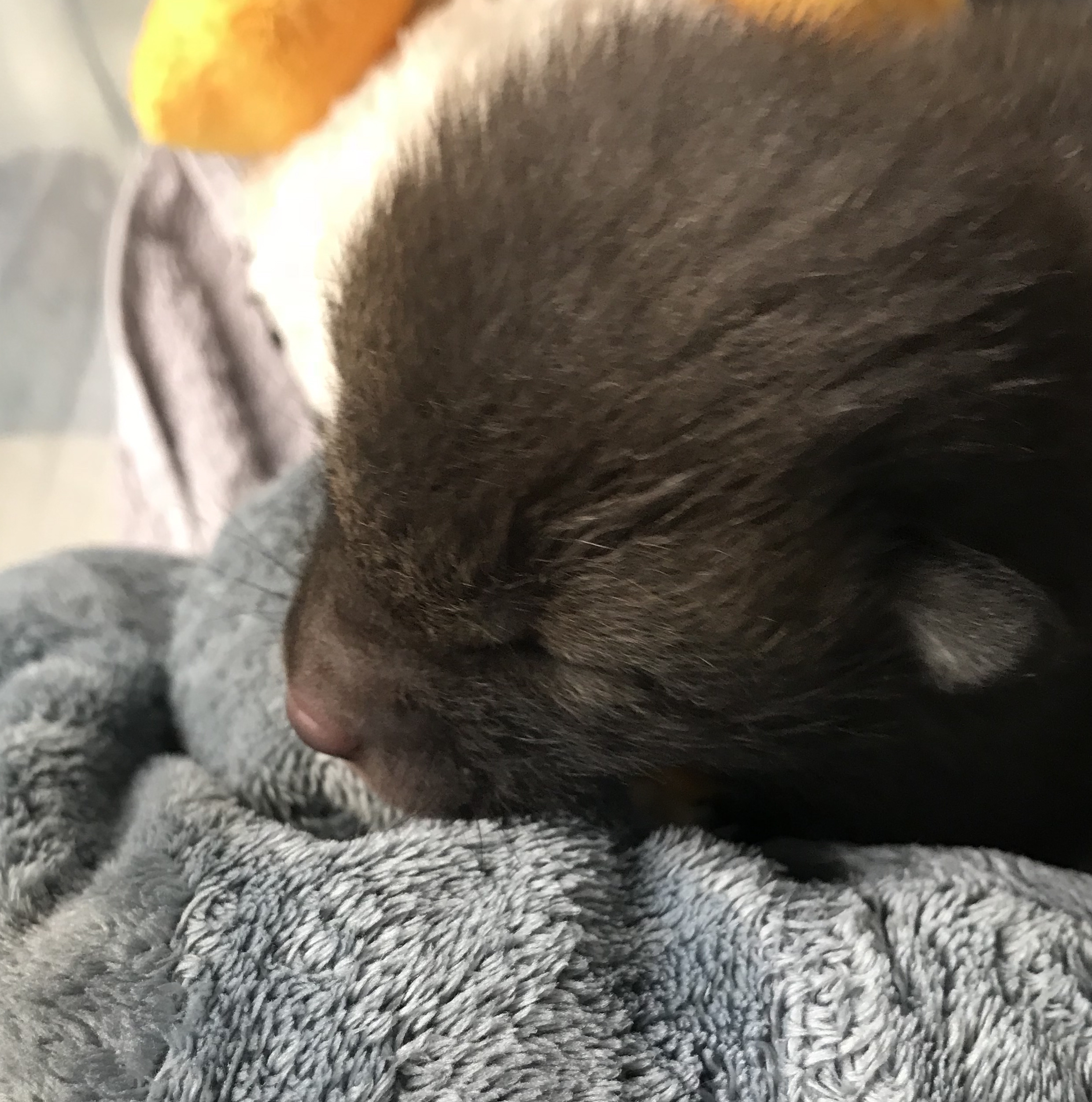
|
| |
| |
|
|
From Winter 2017/2018 Fox's progress
These pictures show a
little fox that had a horrible wound on her face, a large piece of flesh torn right away and a strip of skin hanging down.
The kind householder who feeds this little fox heard a commotion, and the suspicion is that a dog attacked her.
After
treatment by Little Foxes with antibiotics, this little fox made a remarkable recovery and is now visiting her usual garden
for her usual supper, as good as new!
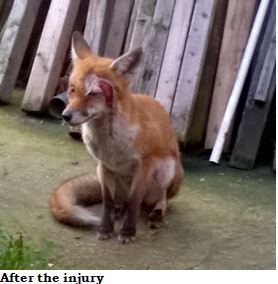
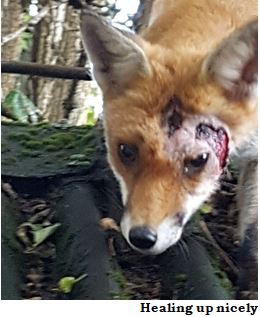 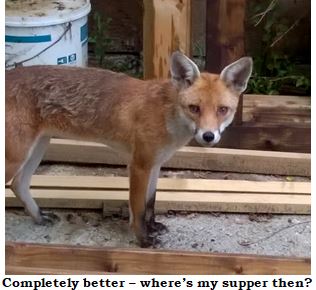
|
|
|
| |
From Summer 2017
Below are three examples of our many success stories!
|
| |
| |
|
|
From Winter 2016/2017
You never can tell...
January is of course quite a quiet month, but I think today there must
be something in the air! In the space of just three hours we have had the following enquiries to deal with:
An injured blackbird
An injured goose
A fox hanging by the leg from a barbed
wire fence
A duck that can’t fly
A sickly collared dove
A collapsed fox
Two of these were well out of our area but we were able to advise and arrange for local assistance.
That’s the way it goes in wildlife rescue, you never know from day to day what you will be asked to help with.
We took in this little stray chick...
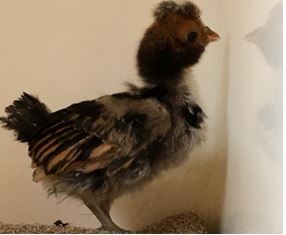
...and look what he turned into!

|
|
|
| |
From Summer 2016
Well done Shelley!
Fosterer Shelley has been very busy during the summer, and I thought it was worth
showing you these two pictures of a young rook that came to Shelley in an advanced state of starvation. She took great
pains to carefully look after this poor bird, and the results, before and after, can be seen below.
|
| |
| |
|
|
From Winter 2015/2016
A Red Kite In A Pickle 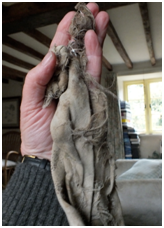 In October a red kite was brought in to us by two concerned gentlemen. You never know what you are going to see when
casualties arrive, and I was taken aback when I looked at this bird. In October a red kite was brought in to us by two concerned gentlemen. You never know what you are going to see when
casualties arrive, and I was taken aback when I looked at this bird. Tangled tightly
round the kite’s foot was a length of thin, frayed fabric (see photograph). It was wound around the bird’s
toes so tightly that it had rendered that foot completely non-functional. It was with the utmost satisfaction that I
set to work with a pair of sharp scissors and relieved the kite of its horrible and unwanted burden. It took a little
while, as it was obviously important to take care not to cut the bird in the process. However, it all came away and
I then just had to remove the fraying fibres which were still tightly wound all around the foot. The kite’s middle
toe was actually virtually severed, attached by only a thin and dry piece of skin. The toe was completely dead, and
one snip removed it painlessly.
Thankfully the remainder of the foot still had a blood supply, and was saved.
The stump of the lost toe was a worry for a time because of the danger of gangrene, but fortunately it remained dry and free
of trouble. 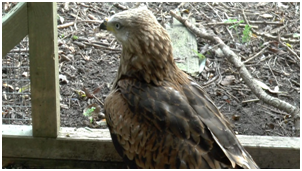
After cage rest to allow the bird to recover, it soon looked so much brighter that I moved it into an aviary,
where it spent a number of weeks of convalescence. The loss of a middle toe in some birds of prey would be pretty serious,
as the talons are used to capture the prey. I believe most would still be able to carry on hunting successfully however,
although I admit it would take some careful thought to decide if they should be released back to the wild. However,
the case of a red kite is a bit different, as they are mainly scavengers, and therefore are not using their feet as weapons
in the same way as other birds of prey. Kites do kill some live prey, but most of their diet consists of carrion. 
The kite regained his strength in due course, putting back on the weight he had lost while hampered by his ragged
burden, and getting used to gripping with his two claws. I decided the time had come for his release. I opened
the door of the aviary and he swept regally past me and up into the air.
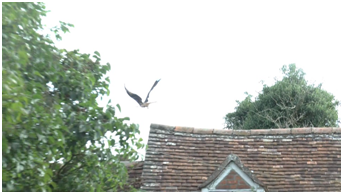
Many people think that the trauma of being handled by humans will be just too much for a bird to cope with, and indeed
occasionally it can be, but it is not if the bird is treated with consideration. Some species are less able to cope
than others, the prime panickers being blackbirds and wood pigeons. The latter are a real challenge sometimes, shedding
feathers all over the place and often smacking you hard (in the face, usually) with a very powerful wing.
If a bird in trouble is to be helped it must be picked up and it must be handled when it arrives at a rescue. Most
birds will cope with this perfectly well, and the danger lies in persisting to handle the bird when it is showing signs of
being overcome with stress. If a bird starts to gasp with open beak, or its head begins to droop, it must be immediately
put into a quiet, dark cage to allow it to recover – if the handling continues at this point, it could even die in your
hands.
Like everything else in wildlife care, this is a matter of experience and judgement. Wild animals
can cope with a great deal of intervention when their plight demands it, and it saddens me a great deal when the knee jerk
reaction of “it’s a wild animal, put it to sleep” gets in the way of allowing a wild animal or bird to receive
the care it needs to get it back to the wild, whole and healthy once again.
|
| |
| |
|
|
From Spring 2015
Foxes
with mange
The sanctuary also receives many calls from people reporting foxes suffering from mange.
These calls come from all over the British Isles. Most calls involve foxes that are already being fed by the people ringing,
and so it is easy to help by sending out the homeopathic remedy for mange (Arsen. Sulph.) which is then put on the food, and
over a period of about three weeks (in the vast majority of cases) brings about a remarkable recovery. In the rare cases
where the homeopathic remedy does not do the job, the fox then needs to have Ivomec, a drug which kills the mange mites and
definitely cures mange. We can supply this to people who are local and who can collect it from us, but for people further
afield we recommend they ask their own vets to ring us and hope they will agree to supply the Ivomec, which can also be put
on food. This needs to be done only with foxes who can actually be seen taking food, are regular visitors (and foxes tend
to turn up at the same time every night) and so there is no question of the drug being taken by the wrong animal, or left
lying about. We are now sending out so much homeopathic remedy that it does cost the sanctuary quite a lot, as people
rarely offer to pay themselves, or offer a donation; however, this is money extremely well spent because mange is a terrible
thing, and a fox will usually die eventually if this is not treated. It is not a pleasant death. I am very strongly in
favour of treating foxes in their own environment as often as possible. Where practicable we do this, often using homeopathic
remedies to very good effect. They are harmless if picked up by anything else and cannot be overdosed. By treating foxes in
this way it avoids the stress of capture and treatment in a sanctuary, and although of course it is not always practical,
it is something I am expanding as time goes on, where the circumstances are appropriate. One of the nicest things that
can happen is when I am sent photographs of the recovered fox, having benefitted from our intervention. What could be more
satisfying? The fox is unaware it has even been treated, but must be so much happier now it feels better! |
|
| |
From Autumn 2014
Trichomoniasis
Symptoms
to look out for are a lethargic, fluffed up bird, often sitting on the ground as it is too weak to fly. Closer examination
will reveal a messy beak with saliva smeared around it. On opening the beak, creamy coloured, very smelly deposits can be
seen in the mouth, on the tongue and in the throat. These eventually block the bird’s throat, making swallowing
food impossible. They can, as the disease progresses, spread in the internal organs, particularly the respiratory system.
It is very infectious to other similar birds, and is passed on via saliva. It is therefore very helpful if you
can keep any bird tables on which pigeons and doves feed very clean, using disinfectant to give a regular, thorough scrub,
and clear away any seed every day that has been left. It is well worth this effort to prevent further spreading of this
very nasty, and usually lethal disease. Sadly adult pigeons affected with tric will certainly pass it on to any young
they are feeding, as the beak is pushed into the baby’s mouth, making a direct route for infection.
When
we do have success and manage to turn a tric affected bird around, it is very satisfying, as the foul deposits start to slide
easily off the mouth, and the bird begins to feel so much better. If any attempt is made to pull off the deposits
before the bird is treated, it will cause bleeding, which can be severe, and can fill the bird’s throat, and even cause
drowning and death.
|
|
|
| |
From Autumn 2014
Weasely Goings On
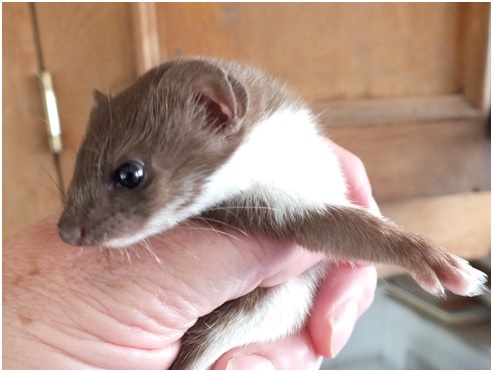 One of my all time favourite animals is the weasel. The weasel is another animal persecuted by gamekeepers, who
trap thousands of these lovely little creatures with the indefensible aim of preserving all the thousands of pheasants released
each August for idiots to later pay a fortune to blast from the sky, where they have been forced by beaters frightening them
out of the undergrowth. So what if a weasel took an occasional pheasant, which is very unlikely anyway unless the birds were
very young, and most of those are in intensive rearing, factory-style sheds. One of my all time favourite animals is the weasel. The weasel is another animal persecuted by gamekeepers, who
trap thousands of these lovely little creatures with the indefensible aim of preserving all the thousands of pheasants released
each August for idiots to later pay a fortune to blast from the sky, where they have been forced by beaters frightening them
out of the undergrowth. So what if a weasel took an occasional pheasant, which is very unlikely anyway unless the birds were
very young, and most of those are in intensive rearing, factory-style sheds.
This year we have taken in two little
weasels, the second one being so young that his eyes had still not opened. The first was a juvenile that just needed
a few weeks of looking after before release, but the second needed hand feeding for about three weeks before he began to feed
himself.
It was a joy to watch this little chap playing, bouncing and leaping around in his large glass tank.
Because they are so tiny and so lithe, weasels can escape from most cages, thus a tank is the most sensible accommodation
for them. As he grew, his fur darkened and took on a rich chestnut brown, contrasting beautifully with his white undercarriage.
As he had no companion, I played with him a bit while he was young, letting him make merry with my fingers while I tickled
his tum and generally let him have a bit of rough and tumble play. I stopped this as he got bigger, to ensure he retained
all the proper fear of humans. He then played with little soft toys, an empty cotton reel, cardboard tubes, and a special
favourite, an empty strong plastic tub which took on an apparent life of its own as he disappeared inside it and proceeded
to roll it around, tip it up over his body, chuck it off again, etc, etc. His sharp little face, so small and yet radiating
such life and intensity, was utterly gorgeous.
He has now been released, as has the one taken in earlier this year,
well away from gamekeepers of course. I provided food for them after release, and in fact as the latter of the two was
only released a couple of weeks ago, I am still providing food for him, if he wants or needs it. Let’s hope they
are both thriving and enjoying all the things that life in the wild has to offer them.
|
| |
| |
|
|
From
Winter 2013/2014
Foxes Needing Help
We continue to treat foxes with mange,
whenever possible, in their own environment by sending out the homeopathic remedy which is put on the food provided by the
householder. This is very successful in the majority of cases.
However, sometimes
people just won’t even do their bit and put out food for the affected fox. Mostly, the people who contact us are
already feeding the fox, and the situation is then straightforward. Sometimes however they are not, and although most
will willingly start to do so in order to help the fox, sadly, some just want the mangy fox out of the way, rather than wanting
to see the animal get better from this horrible condition.
As Little Foxes receives
calls from all over the country it is very difficult if the caller refuses to help, and they are a hundred or more miles away.
I always give contact details of sanctuaries nearer to them that they can contact, but I sometimes get the feeling they just
won’t bother to do anything.
This is very sad, because mange will slowly kill
if not treated, through secondary infections, and the sheer debilitation it causes in the affected animal. A rare few
foxes seem to have the ability to overcome mange without intervention, but so many will not do so without help.
|
|
|
| |
From
Summer/Autumn 2013
A Cuckoo Calls
I absolutely love cuckoos, and am very worried
about the serious decline in their numbers. Spring is spoilt if you don’t hear a cuckoo.
A few weeks ago I received a call from an elderly lady who had found a bird on the ground, which she thought was
a sparrowhawk, but she had been advised by a neighbour that it was a cuckoo. I met this very elderly lady halfway between
her home and Little Foxes, and she passed to me what was indeed a cuckoo. The bird is a juvenile, born this year, and
it was completely off its legs, something I hate to see in a bird as it rearely gets better. It was also extremely
thin and malnourished.
Slowly this lovely cuckoo has regained the use of his/her legs and can now perch on a branch.
I had to hand feed it for about three weeks, and then to my great relief it started to peck enthusiastically at wax
worms and mealworms. 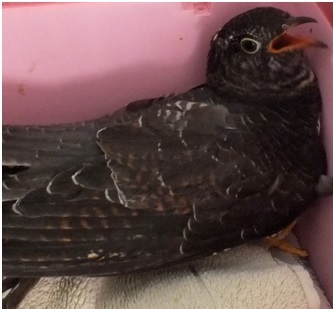
The problem is that it is too late to release it and expect it to fly safely all the way to Africa. I shall
keep it and see it if gets fully fit during the Autumn months, in which case I may ask an airline to fly the bird to Africa
(free of charge of course!) That would however be risky because of the stress involved. If not I can only hope
it can survive until the spring and be strong enough to be released here then. Migratory birds usually do not do well
if kept over the winter, and I am worried about this, but I could not contemplate having the bird put to sleep, so we shall
have to hope for the best. It is currently coping well and certainly improving. It is a tricky patient,
as it will have to stay in the warm inside over the winter, whereas ideally it should be out in an aviary so that it can fly
about and strengthen up its muscles. I shall provide the best possible space for it inside, and see how things
go.
As the bird is a juvenile it still has brown feathers rather than grey. It will be interesting, if it
survives, to see whether it turns out the be a male or a female. The best possible outcome from my own (selfish!) point
of view would be that the bird survives the winter, can be released in the spring, and is a male, so that I can have the joy
of hearing a cuckoo calling right outside my house next year! |
|
|
| |
From Spring 2013
Unusual Baby Birds
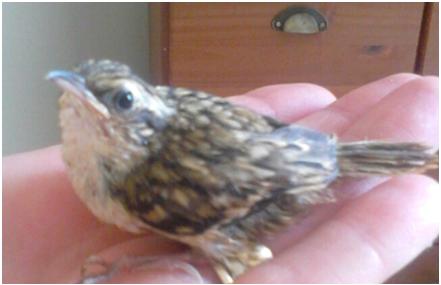
Recently fosterer Lucy collected four very young baby birds and delivered them to Claire, our new fosterer. After
some confusion we have now identified them as treecreepers. Until the beaks started to curve downwards we were not positive,
but this is now happening. Unfortunately the two smallest birds have not made it, but the remaining two are now fully
feathered and flying around their cage. Claire has done a great job, as the younger the babies are when they come in,
the more challenging is the task of rearing them.
Long Tailed Tit
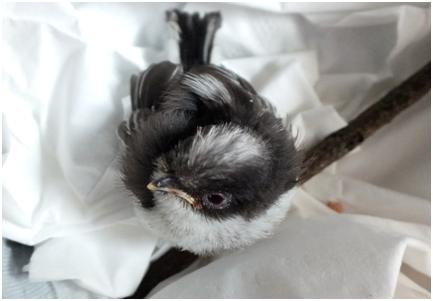
I have just reared a baby long tailed tit, one of my favourites. They are like little fluffy ping-pong balls
with a long tail added on. These birds go around in gangs, and so having one on its own is a real shame. The little
bird is now ready for release, and the best I can do for her is to take her to a piece of woodland which is typical long tailed
tit habitat and hope she can muscle in with a group. |
|
|
| |
From Winter 2012/2013
Harry's Homework
A short while ago we heard from a lady whose 8-year-old nephew had done a project
for school, all about foxes. Harry is very keen on foxes, and we are pleased and proud to now have him as a member of
Little Foxes. Here is an excerpt from Harry’s excellent project:
What is a Fox?
A Fox is
an animal that should be cared for, and not hunted for what it does to survive. People usually get mad at these animals and
refer to them as “Pests”. However, I am one child who thinks that the public is wrong because they have to eat
and drink; so do you.
A Fox is a living thing, but on all fours, claws, a tail, muzzle, and a fur coat of course,
so really they just haven’t developed like us, but they are still a living thing. Urban foxes are pesky, you may think,
but they aren’t. Farmers think that Red Foxes are rodents because they often sneak into farms, to eat the chickens,
but it’s to survive when they cannot find food in their natural habitat.
People should care for these marvellous
animals, not hunt them.
Well said Harry!
|
| |
| |
|
|
From Winter 2012/2013
A heartwarming hedgehog story 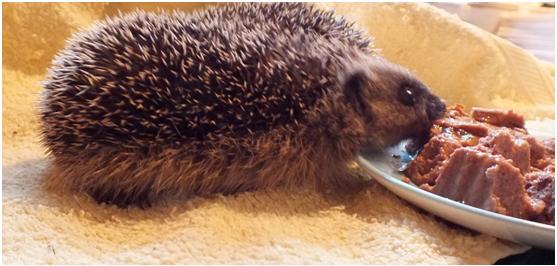 You just never know what you are going to take
in next, or what you are going to hear about next, when you have a wildlife sanctuary. I was contacted by a recycling centre
in Oxford in the later part of the Summer, and they wanted help with three baby hedgehogs.
The hogs had been found
– believe it or not – in a skip, and what’s more, in the landfill skip. It is just possible that they were
accidentally put in there, but there is also the dreadful possibility that they had been deliberately thrown away in the most
callous way.
But these two little hedgehogs were very lucky, because a sharp-eyed worker at the centre noticed
them, rescued them, and notified his boss, leading to the call to us. We collected the hedgehogs straight away, and I was
relieved to see that they appeared to be healthy and uninjured. They were hungry and thirsty, but that was soon remedied.
They stayed with me for a time, and their rescuer visited with another Council employee so that he could be photographed
with them for the story to go on the Council’s website.
Carol now has the hedgehogs in her care, and they
are scheduled for release in the coming Spring. We called them Skippy, Landfill and Compost. One of them is pictured
below enjoying a meal after arrival at the sanctuary.
|
| |
| |
|
|
|
From Summer 2012
Moonraker the leveret
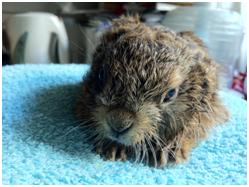 It has been my privilege this year to rear a beautiful little leveret. Moonraker came in having been found near a barn,
in a dangerous situation as a large wedding reception was being held that afternoon at the barn. I was concerned that
this very young hare may not in fact be an orphan, as leverets are left hidden in the grass by their mothers for long periods,
but when he arrived, I could see and feel that he was underweight, and I think he was a genuine orphan. It has been my privilege this year to rear a beautiful little leveret. Moonraker came in having been found near a barn,
in a dangerous situation as a large wedding reception was being held that afternoon at the barn. I was concerned that
this very young hare may not in fact be an orphan, as leverets are left hidden in the grass by their mothers for long periods,
but when he arrived, I could see and feel that he was underweight, and I think he was a genuine orphan.
I was lucky
that he took fairly quickly to being hand fed, probably because he was very hungry. Leverets are notoriously difficult
and tricky animals to deal with, and can die unexpectedly at any time during the process. Thankfully Moonraker behaved
pretty straightforwardly, and was a pure delight from start to finish. 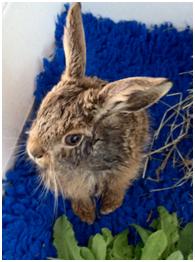 There is just something about hares. It is very difficult to put into words, but it is obvious that many people are
aware of it, because the hare has been a creature of legend for centuries, and the hare goddess Oestre in pagan beliefs was
the goddess of fertility and the Moon. Hares have always been linked to the Moon, and the myths and legends that surround
hares are very beautiful. They are worth looking up and reading about. There is just something about hares. It is very difficult to put into words, but it is obvious that many people are
aware of it, because the hare has been a creature of legend for centuries, and the hare goddess Oestre in pagan beliefs was
the goddess of fertility and the Moon. Hares have always been linked to the Moon, and the myths and legends that surround
hares are very beautiful. They are worth looking up and reading about.
The hare is of course another animal that bloodsports barbarians love to hunt and kill. The disparity between
the absolute beauty, intelligence and vulnerability of wild animals, and the depravity and brutality of those that harm them,
is absolute, and hard for the mind to grasp.
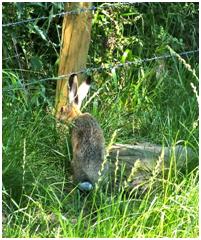 I hope the photographs will go some way to showing what an utterly delightful animal this little hare was. It was my
privilege to look after him and give him the help he needed. I hope the photographs will go some way to showing what an utterly delightful animal this little hare was. It was my
privilege to look after him and give him the help he needed.
Once again, never forget that we can only do this
work because of the help and support we get from our loyal friends - i.e. YOU!Moonraker
on release
|
| |
From Summer 2010
Another baby polecat
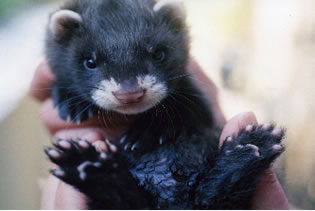
You will remember Nipper the polecat who featured in the last couple of Newsletters - well we now have
another young male polecat, Cracker (above) who also came into us as an orphaned baby. He was found in a bad way beside a
road, and it is very lucky that his rescuers were sensible people who could see this animal was all alone and in trouble.
It didn’t take little Cracker long to recover from his debilitated state, and he is now absolutely gorgeous and full
of the joys.
|
| |
| |
|
|
|
 |
From Winter 2007
Hedgehogs Flock In
You
may have read reports in the newspapers about the numbers of late baby hedgehogs being taken in by sanctuaries, and Little
Foxes is no exception. Although this is being interpreted as another sign of global warming, in fact it does happen every
year. Hedgehogs always produce late-season babies that, illogically, have little or no chance of putting on enough fat
to survive hibernation. Having said that, this year we have taken in a record number of these little critters, and have,
as always, seen a fair number of them succumb, despite all our loving care.
Nevertheless we still have a good number
of these to release in the spring, to swell the numbers of this apparently diminishing species. Undoubtedly hedgehogs
are suffering badly as our summers become increasingly hot and dry. It cannot be said often enough how important it
is for us all to put out food and water every night during periods of drought to help these little animals survive.
I have one poor old chap here with me who came in suffering from horrible injuries caused by a strimmer (something I would
love to ban!). He was cut around his ears and face, but thankfully his eyes survived unscathed, and he still has a nose,
unlike some of the strimmer victims I have seen. He has been here for many weeks, and is very slowly but surely repairing
and recovering. He eats well and seems a placid sort of chap.
Despite the hedgehog tendency to expire for
many mysterious and hidden reasons, some can cope with and survive truly horrendous injuries. Many is the maggot-infested,
infection-ridden hedgehog victim that has caused me to shake my head in horror and pity, that has stoically and matter of
factly got on with life and recovered. Sometimes they co-operate as little as possible with us, their well intentioned carers,
as we try and tend a tightly curled up ball of prickles who seems determined to hang on to every wriggly maggot and every
speck of malodorous pus, but, hey, perseverance is our middle name here.
|
| |
| |
|
|
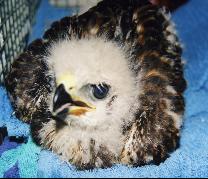 From Summer 2007
Buzzard Baby
One wet Sunday a call came through from two ladies
who had found a very bedraggled baby buzzard on the roadside.
Until the bird actually arrived, I was
doubtful if it really was a buzzard, as it is easy for people to misidentify birds, but sure enough they were right. I was
suspicious about how this poor bird came to be in such trouble, as it was found near a very large shooting estate, and we
all know that, despite their protected legal status, birds of prey are still unlawfully killed by gamekeepers sometimes. She
was far too young to be out of the nest, and I wondered how both parents had managed to disappear, leaving a very distressed
baby to struggle out of the nest and wander onto the road. It might have been otherwise,
I don’t know, and never
will.
The baby buzzard was wet, cold and very thin indeed. Further examination revealed a squirming mass of maggots
on the top of the head, and another on the side of the throat. Fluids were administered, the bird was relieved of its maggots
and the wounds cleaned, an antibiotic administered (as maggot infestations invariably result in mucky infection in the wound
site), and the bird was placed in a heated cage. She was fed mainly rehydrating fluid for the first evening, moving on then
to tiny pieces of food, and finally to a normal amount of food as her body became capable of dealing with it...
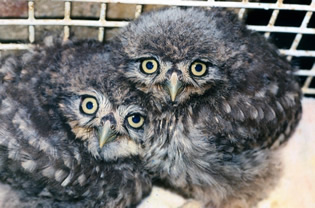
|
 |